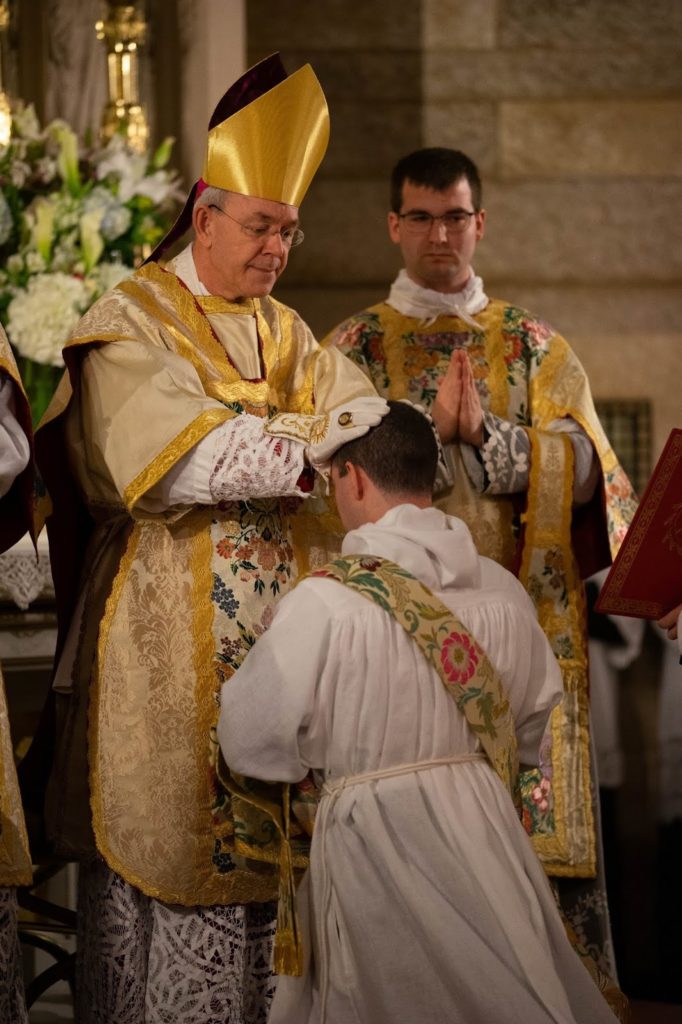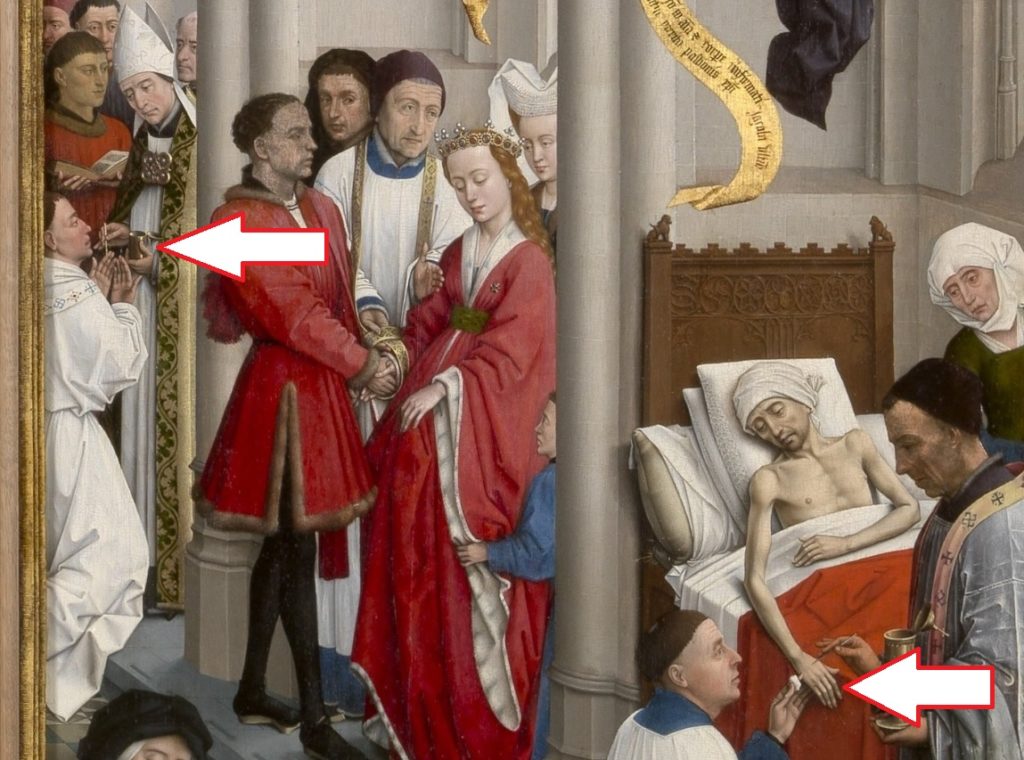QUAERITUR:
In a May 14, 2020 dubium to the Holy See, the USCCB asked if an instrument such as a cotton ball may be used for the anointing with sacred Chrism during the celebration of the sacrament of Confirmation, much as the law allows for “an instrument” to be used for the anointing during the Anointing of the Sick. The Congregation for Divine Worship and the Discipline of the Sacraments replied on June 2, 2020 that “The use by the minister of an instrument (gloves, cotton swab…) does not affect the validity of the Sacrament.” A cotton ball or cotton swab may therefore be used—one for each candidate—and then disposed of by burning afterward. Were a glove to be used, it would need to be changed between each anointing. If no cotton ball, cotton swab, or glove is used, priests must wash or sanitize hands between each anointing so that the Sacred Chrism is not contaminated nor is contagion spread between candidates.
How can that be? What about the “imposition” of the hand which in the NO was reduced to the contact in the anointing itself. Now even that is gone.
Can we say The response of the Vatican is “wrong”?
The CDW responded that an instrument may be used for the administration of the Oil of the Infirm in the Sacrament of Anointing.
That is disturbing. It directly contradicts previous teaching and tradition.
Who am I to question the CDW in these matters? After all, I am just an Unreconstructed Ossified Manualist. So let’s check on our sources.
Mind you… what I am about to write applies to the TRADITIONAL manner of administering the Sacrament of Confirmation. By no means can the CDW response be applied to the TRADITIONAL celebration of the sacrament.
Also, as far as the Novus Ordo goes, the Church gets to decide about the matter and form of the sacraments, provided that their divine institution is not violated. The Church cannot, for example say that rice cakes can be used for the Eucharist. But the Church can, for example, change the form, the essential words, for the Sacrament of Confirmation or of Holy Orders, and what instruments are used, such as the traditio instrumentorum in the rite of ordination.
His scriptis, there are still important principles to deal with. If we believe that sacraments have matter and form (and we do) then we have to figure out if the use of an instrument for the anointing with Chrism in Confirmation is permissible. Theologians in the past have always… always… answer NO. The hand must be used without and instrument, because the hand of the minister is connected to the matter of the sacrament.
Turning to Sabetti-Barrett’s 1919 edition of Compendium Theologiae Moralis, I read (in Latin):
669. Query. – Question 2. How is the anointing to be done?
Response. It must be done with the right thumb of the Bishop in the manner of a cross on the forehead of the one confirmed. However, the anointing would be valid if it were done by a different digit of the Bishop, and even if it were a digit of the left hand, because it would be an imposition of the bishop’s hand. But a Bishop would sin, were he to do that without necessity, because he would be departing from the universal praxis of the Church; albeit it does not seem that an inversion of the aforementioned ceremony would reach the level of grave guilt. – Cf. S. Alphons. n. 165
Question 3. Whether anointing can be done validly by means of an instrument?
Response. NEGATIVE., and the reason is, that the immediate imposition of the hand of the Minister would be lacking, which is absolutely required from what has been said. On this in the new Code (1917):
§2. Anointing is not to be done with any instrument, but it is imposed properly by the hand of the minister on the head of the confirmand.
Prümmer in the 1953 Manulae Theologiae Moralis says:
156. 3. The anointing must be done with the thumb of the right hand, and not with a stylus or another instrument, as has already been said. If, however, the bishop has a bad thumb, he can licitly anoint with the thumb of his left hand or with another digit.
We must grant that THE CHURCH gets to determine how the sacraments are to be administered. However, the 2020 CDW response seems to ignore the opinions of theologians which the Church has, hitherto, rested on for a contrary opinion. I don’t think they can simply be left aside.
We still need to have distinctions such as proximate and remote material, if we still believe in matter and form.
Let’s go another step.
Is the imposition of the hand hitherto required accomplished if a glove is worn?
The answer is surely YES.
I would you to the imposition of hands to the rite of ordination of priests.
It seems that an essential imposition of hands, when required, is accomplished with the use of gloves.
Could one say that the gloves are instruments. Not really. They do not significantly distance the hand from the head. An instrument does (which is the point of using it).
Hence, in the administration of the Sacrament of Confirmation, the bishop can anoint using a gloved hand, but he cannot use an instrument to anoint. I think the Congregation’s response is wrong and that it is highly likely that the use of an instrument to anoint with Chrism for Confirmation (not Anointing) is invalid.
A bishop or priest can use an instrument to anoint in the Sacrament of Anointing, because imposition of the hand is not required for the administration of the sacrament. However, our best theologians, with St. Alphonsus, are firm on this point: the bishop must confirm with his hand, not an instrument. His hand can be gloved, but the Chrism must be applied with a finger of his hand and not through an instrument.
In any event, I hope this gives any priest (with permission to confirm) and any bishop serious pause in the matter of using an instrument to apply Chrism. DON’T DO IT.
I think this needs greater clarification.
Meanwhile, allow me to muddy the waters a little. In the 15th c. Rogier van der Weyden – a painter with a sharp eye – thought bishops could confirm using an instrument. This is from his amazing Seven Sacraments Altarpiece.
First, the bishop is clearly confirming.
And for Ordination to the Priesthood and for Extreme Unction.
Again, the Church gets to decide how sacraments are celebrated, what the matter is and what the form is. If, however, this constitutes a departure from previous theology, the Congregation should be clear about that.
Salvo meliore iudicio, of course. But I would ask that this be reviewed and clarified by the same Congregation.
Comment moderation is ON.






































The reasoning may have to do with Thomistic concepts of causality. For instance, the famous example of God’s causality in nature as being a hand which holds a stick which pushes a rock. In which case, the ontological relationship escapes being reduced to an infinite regress, such as one God creates one rock, then another, then another.
Also, we ought to consider that at least in the Byzantine Rite, a “brush” is used to administer anointings, whether it is the actual Sacrament, or blessings in general, such as after Divine Liturgy.
Gloves would not negate the “causation” of the hand because they are, so to speak, an extension of the agency of the hand, not a replacement. The “member” of the body still performing the Sacramental Matter is still the hand.
In a certain sense, a cotton swab is probably less of an obstacle between the minister’s thumb and the candidate’s forehead than the traditional glove, and the motions required are pretty much the same since the fingers holding the swab have to be right by the forehead. Using a 6-foot rod to attempt this would be more obviously against the form.
That said, this is getting to be silly season. The prudent choice if it is not deemed safe to administer confirmation in the form given is to wait until it is, not butcher the form just to get the confirmations out of the way as fast as possible. Confirmation is only done once and candidates have a right to it being done properly.
It seems in these considerations that the thought process and the burden is overwhelmingly placed upon the priest, which complicates things because typically there is one priest and many faithful. Why was there no consideration or recommendation that instead of the priest’s hand/thumb being purified between each confirmand, instead the forehead of each confirmand would be purified (cleaned with isopropyl alcohol, etc., with a cotton ball), thereby taking away the need to remove the Chrism and purify the thumb between each anointing. Further, if the concern is about the breath of the confirmand contaminating the priest’s hand, then require the confirmandi to wear masks.
Well and succinctly put Adeodatominia! The extension argument is a good one and the issue is also doing what the Church intends. The issue is the intention of the Church through which Christ acts. Too much focus on the individual risks Donatsim and magical thinking whereby objects in and of themselves are infused with divine power – they aren’t. They are, at most, set apart for sacred use but the power of any object is in relation to the Church through which Christ acts and power of grace reside in Christ no the object or person.
So yes clearly an object can achieve the intention of the Church